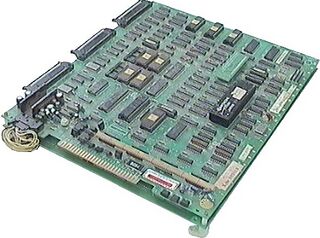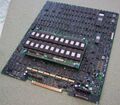Difference between revisions of "Sega System 16"
From Sega Retro
| (2 intermediate revisions by the same user not shown) | |||
| Line 19: | Line 19: | ||
==Technical Specifications== | ==Technical Specifications== | ||
===System 16A=== | ===System 16A=== | ||
| − | *Board Composition: | + | *Board Composition: CPU Board, Video Board |
*Main CPU: [[Hitachi]] FD1094 ([[Motorola 68000]]) @ 10 MHz (16-bit & 32-bit instructions @ 1.75 MIPS) | *Main CPU: [[Hitachi]] FD1094 ([[Motorola 68000]]) @ 10 MHz (16-bit & 32-bit instructions @ 1.75 MIPS) | ||
*Main MCU: Intel i8751 @ 8 MHz (8-bit instructions @ 8 MIPS, 1 instruction per cycle) | *Main MCU: Intel i8751 @ 8 MHz (8-bit instructions @ 8 MIPS, 1 instruction per cycle) | ||
| Line 25: | Line 25: | ||
*Sound MCU: Intel i8048 @ 6 MHz (8-bit instructions @ 6 MIPS) | *Sound MCU: Intel i8048 @ 6 MHz (8-bit instructions @ 6 MIPS) | ||
*FM Sound Chip: [[Yamaha]] [[YM2151]] @ 4 MHz (8 FM synthesis channels) | *FM Sound Chip: [[Yamaha]] [[YM2151]] @ 4 MHz (8 FM synthesis channels) | ||
| − | *PCM sound chip: NEC uPD7751 @ 6 MHz | + | *PCM sound chip: NEC uPD7751 ADPCM Decoder @ 6 MHz |
**ADPCM Channels: 3 | **ADPCM Channels: 3 | ||
**Audio Bit Depth: 8-bit | **Audio Bit Depth: 8-bit | ||
*GPU Chipset: 315-5011 sprite line comparator, 315-5012 sprite generator, 2× 315-5049 tilemap chips, 315-5107 & 315-5108 display timers, 315-5143 & 315-5144 sprite chips, 315-5149 video mixer | *GPU Chipset: 315-5011 sprite line comparator, 315-5012 sprite generator, 2× 315-5049 tilemap chips, 315-5107 & 315-5108 display timers, 315-5143 & 315-5144 sprite chips, 315-5149 video mixer | ||
**Clock Rate Performance: 12.5874 MHz sprite line buffer render clock, 6.2937 MHz sprite line buffer scan/erase & pixel clock | **Clock Rate Performance: 12.5874 MHz sprite line buffer render clock, 6.2937 MHz sprite line buffer scan/erase & pixel clock | ||
| − | *[[RAM]]: 77 KB [[SRAM|Static RAM]] ( | + | *[[RAM]]: 131 KB, including 77 KB [[SRAM|Static RAM]] (SRAM){{ref|https://github.com/mamedev/mame/blob/master/src/mame/drivers/segas16a.c}} |
| − | **Main CPU: 74 KB (32 KB tiles, 4 KB text, 2 KB sprites, 4 KB palette, 16 KB I/O, 16 KB NVRAM) | + | **CPU Board: 76 KB (including 22 KB SRAM) |
| − | **Sound CPU: 2 KB | + | ***Main CPU: 74 KB (32 KB tiles, 4 KB text, 2 KB sprites, 4 KB palette, 16 KB I/O, 16 KB NVRAM) |
| − | ** | + | ***Sound CPU: 2 KB |
| − | *Display [[Resolution]]: | + | **[[VRAM|Video Board]]: 55 KB SRAM |
| + | *Display [[Resolution]]: | ||
**Horizontal: 320×224 (display), 342×262 (overscan) | **Horizontal: 320×224 (display), 342×262 (overscan) | ||
**Vertical: 224×320 (display), 262×342 (overscan) | **Vertical: 224×320 (display), 262×342 (overscan) | ||
| + | **Scanlines: 262 scanlines, progressive scan | ||
*Color Palette: 98,304 | *Color Palette: 98,304 | ||
** 15-bit RGB high color depth (32,768 colors) and 1-bit shadow & highlight that triples up to 98,304 colors | ** 15-bit RGB high color depth (32,768 colors) and 1-bit shadow & highlight that triples up to 98,304 colors | ||
| Line 60: | Line 62: | ||
*GPU Chipset: 315-5196 sprite generator, 315-5197 tilemap generator, 315-5213 sprite chip, 315-5248 & 315-5250 math chips | *GPU Chipset: 315-5196 sprite generator, 315-5197 tilemap generator, 315-5213 sprite chip, 315-5248 & 315-5250 math chips | ||
**[[Sprite]] Capabilities: Sprite scaling | **[[Sprite]] Capabilities: Sprite scaling | ||
| − | *[[RAM]]: | + | *[[RAM]]: 147 KB, including 77 KB [[SRAM|Static RAM]] (SRAM){{ref|https://github.com/mamedev/mame/blob/master/src/mame/drivers/segas16a.c}} |
| − | **Main CPU: 90 KB (2 KB sprites, 4 KB palette, 64 KB tiles, 4 KB text, 16 KB work RAM) | + | **CPU Board: 92 KB (including 22 KB SRAM) |
| − | **Sound CPU: 2 KB | + | ***Main CPU: 90 KB (2 KB sprites, 4 KB palette, 64 KB tiles, 4 KB text, 16 KB work RAM) |
| − | ** | + | ***Sound CPU: 2 KB |
| + | **[[VRAM|Video Board]]: 55 KB SRAM | ||
===System 16C=== | ===System 16C=== | ||
| − | + | System 16C included the following upgrade over System 16B in 2008: | |
| − | *RAM: | + | *[[RAM]]: 387 KB, including 77 KB [[SRAM|Static RAM]] (SRAM){{ref|https://github.com/mamedev/mame/blob/master/src/mame/drivers/segas16a.c}} |
| − | **Main CPU: 330 KB (2 KB sprites, 4 KB palette, 64 KB tiles, 4 KB text, 256 KB work RAM) | + | **CPU Board: 332 KB (including 22 KB SRAM) |
| − | **Sound CPU: 2 KB | + | ***Main CPU: 330 KB (2 KB sprites, 4 KB palette, 64 KB tiles, 4 KB text, 256 KB work RAM) |
| + | ***Sound CPU: 2 KB | ||
| + | **[[VRAM|Video Board]]: 55 KB SRAM | ||
==Gallery== | ==Gallery== | ||
Revision as of 04:52, 7 October 2015

| |||||
| Sega System 16 | |||||
|---|---|---|---|---|---|
| Manufacturer: Sega | |||||
|
The Sega System 16 is an arcade board released by Sega in 1985 as a 16-bit successor to the Sega System 1. Throughout its lifespan, there would be around forty games released on this hardware, making it one of Sega's most successful hardware designs. It was produced in three variants, the Pre-System 16, System 16A and System 16B, though the only differences between the three are clock speeds.
The System 16 is the home to many of Sega's most successful franchises, including Shinobi, Fantasy Zone, Altered Beast and Golden Axe. It popularised the use of the Motorola 68000 CPI and Zilog Z80 combo, something which was copied for Capcom's successful CPS-1 and CPS-2 boards (among other arcade systems of the day), as well as most notably, the Sega Mega Drive.
In order to prevent piracy, as well as illegal bootleg games, many System 16 boards used an encryption system. A Hitachi FD1094 chip, containing the main CPU as well as the decryption key, was used in place of a regular CPU.
Though Pre-System 16, System 16A and System 16B are the three most recognised variants of the hardware, there is technically a fourth, dubbed "System 16C" which was used by the 2008 release of Fantasy Zone II DX: The Tears of Opa-Opa. Fantasy Zone II DX arrived almost a decade and a half after the System 16 hardware was discontinued, however its real arcade release means that System 16C specifications may belong to the Sega System 16 series. Fantasy Zone II DX needs more RAM than any of the other System 16 boards can offer, but the game adhered to other restrictions of the hardware.
Contents
Technical Specifications
System 16A
- Board Composition: CPU Board, Video Board
- Main CPU: Hitachi FD1094 (Motorola 68000) @ 10 MHz (16-bit & 32-bit instructions @ 1.75 MIPS)
- Main MCU: Intel i8751 @ 8 MHz (8-bit instructions @ 8 MIPS, 1 instruction per cycle)
- Sound CPU: NEC uPD780C-1 (Zilog Z80 clone) @ 4 MHz
- Sound MCU: Intel i8048 @ 6 MHz (8-bit instructions @ 6 MIPS)
- FM Sound Chip: Yamaha YM2151 @ 4 MHz (8 FM synthesis channels)
- PCM sound chip: NEC uPD7751 ADPCM Decoder @ 6 MHz
- ADPCM Channels: 3
- Audio Bit Depth: 8-bit
- GPU Chipset: 315-5011 sprite line comparator, 315-5012 sprite generator, 2× 315-5049 tilemap chips, 315-5107 & 315-5108 display timers, 315-5143 & 315-5144 sprite chips, 315-5149 video mixer
- Clock Rate Performance: 12.5874 MHz sprite line buffer render clock, 6.2937 MHz sprite line buffer scan/erase & pixel clock
- RAM: 131 KB, including 77 KB Static RAM (SRAM)[1]
- CPU Board: 76 KB (including 22 KB SRAM)
- Main CPU: 74 KB (32 KB tiles, 4 KB text, 2 KB sprites, 4 KB palette, 16 KB I/O, 16 KB NVRAM)
- Sound CPU: 2 KB
- Video Board: 55 KB SRAM
- CPU Board: 76 KB (including 22 KB SRAM)
- Display Resolution:
- Horizontal: 320×224 (display), 342×262 (overscan)
- Vertical: 224×320 (display), 262×342 (overscan)
- Scanlines: 262 scanlines, progressive scan
- Color Palette: 98,304
- 15-bit RGB high color depth (32,768 colors) and 1-bit shadow & highlight that triples up to 98,304 colors
- Colors on Screen: 4096 (unique colors) to 6144 (with shadow & highlight)
- Graphical Planes:
- 1 sprite layer
- 1 text layer
- 2 tile layers (row & column scrolling, 8×8 tiles)
- Sprite Capabilities: Dual line buffers, double buffering, 128 on-screen sprites
- Fillrate per Scanline: 800 sprite pixels/texels (800.75 sprite processing ticks) per scanline
- Sprites per Scanline: 100 sprites per scanline
- Colors per Sprite: 16
- Sprite Sizes: 8 to 256 pixels width, 8 to 256 pixels height
System 16B
System 16B included the following upgrades in 1986:
- Sound CPU: Zilog Z80 @ 5 MHz (8-bit & 16-bit instructions @ 0.725 MIPS)
- PCM Sound Chip: NEC uPD7751 ADPCM Decoder @ 640 kHz
- ADPCM Channels: 8
- Audio Bit Depth: 9-bit
- Other Features: 8 kHz sampling rate, up to 128 KB audio ROM and 256 samples
- GPU Chipset: 315-5196 sprite generator, 315-5197 tilemap generator, 315-5213 sprite chip, 315-5248 & 315-5250 math chips
- Sprite Capabilities: Sprite scaling
- RAM: 147 KB, including 77 KB Static RAM (SRAM)[1]
- CPU Board: 92 KB (including 22 KB SRAM)
- Main CPU: 90 KB (2 KB sprites, 4 KB palette, 64 KB tiles, 4 KB text, 16 KB work RAM)
- Sound CPU: 2 KB
- Video Board: 55 KB SRAM
- CPU Board: 92 KB (including 22 KB SRAM)
System 16C
System 16C included the following upgrade over System 16B in 2008:
- RAM: 387 KB, including 77 KB Static RAM (SRAM)[1]
- CPU Board: 332 KB (including 22 KB SRAM)
- Main CPU: 330 KB (2 KB sprites, 4 KB palette, 64 KB tiles, 4 KB text, 256 KB work RAM)
- Sound CPU: 2 KB
- Video Board: 55 KB SRAM
- CPU Board: 332 KB (including 22 KB SRAM)
Gallery
Pre-System 16
Sega System 16A
Sega System 16B
List of Games
Pre-System 16
- Major League (1985)
- Body Slam / Dump Matsumoto (1986)
- Alien Syndrome (1987)
- Quartet (1987)
- Quartet 2 (1987)
System 16A
- Action Fighter (1986)
- Alex Kidd: The Lost Stars (1986)
- Fantasy Zone (1986)
- SDI (1987)
- Shinobi (1987)
- Time Scanner (1987)
- Sukeban Jansi Ryuko (1988)
- Tetris (1988)
- Wonder Boy III: Monster Lair (1988)
System 16B
- Alien Syndrome (1987)
- Bullet (1987)
- Dunk Shot (1987)
- Sonic Boom (1987)
- Time Scanner (1987)
- Super League (1987)
- Charon (198?)
- Altered Beast / Juuouki (1988)
- Dynamite Dux (1988)
- Heavyweight Champ (1988)
- Passing Shot (1988)
- Sukeban Jansi Ryuko (1988)
- Tetris (1988)
- Wonder Boy III: Monster Lair (1988)
- Ace Attacker (1989)
- Bay Route (1989)
- ESWAT (1989)
- Excite League (1989)
- Flash Point (1989)
- Golden Axe (1989)
- M.V.P. (1989)
- Tough Turf (1989)
- Wrestle War (1989)
- Aurail (1990)
- Ryu Kyu (1990)
- Cotton (1991)
- Riot City (1991)
- Touryuumon (1994)
System 16C
| Sega arcade boards |
|---|
| Originating in arcades |
|
77
78
79
80
81
82
83
84
85
86
87
88
89
90
91
92
93
94
95
96
97
98
99
|
| Console-based hardware |
|
84
85
86
87
88
89
90
91
92
93
94
95
96
97
98
99
00
01
02
03
04
05
06
07
08
09
10
11
12
13
14
|
| PC-based hardware |
|
05
06
07
08
09
10
11
12
13
14
15
16
17
18
19
20
21
22
23
|



